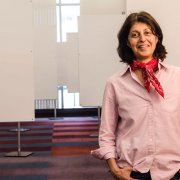by Raleigh McElvery
A lifelong interest in teaching brought Mandana Sassanfar to MIT, where she has established programs to engage diverse students and forged partnerships with institutes across the country.
Of all the offices in Building 68, Mandana Sassanfar’s is perhaps the most colorful. Her walls are lined with photos of students past and present, each of whom completed one or more of the six outreach programs she heads as the Department of Biology’s director of outreach. Over the last two decades, Sassanfar has forged partnerships with communities across the country, in an effort to engage historically underrepresented groups in science — and increase access to MIT’s on-site and online resources.
Although she was born in Switzerland, Sassanfar spent most of her childhood moving between France and Iran for her father’s job. No matter where her family lived, she always attended French-speaking schools. As early as fourth grade, she remembers analyzing her instructors’ teaching strategies, and practicing how she would explain the same concepts to make them clearer. While this interest in education continued to percolate, she also discovered that her favorite subjects were chemistry and math.
By 1983, she’d earned a master’s in biochemistry from Pierre and Marie Curie University in Paris, and moved to the US to start a PhD at Cornell University. Although she nearly switched tracks to study plant science, she ultimately stuck with biochemistry in the hopes of studying under well-known scientist Jeffery Roberts. Although Roberts was not taking new students at the time, Sassanfar convinced him to let her complete an eight-week rotation in his lab.
“I scheduled that rotation as my last, so I would have made every mistake before working with Jeff’s group,” she says. “At the end of the eight weeks, I literally told him, ‘If you don’t take me, I’m going back to France.’ And he took me in.”
While everyone else was probing various aspects of transcription antitermination, Sassanfar was an outlier investigating the role of DNA replication in the bacterial SOS repair pathway following DNA damage. She was among the first researchers to design a quantitative western blot assay to measure the level of LexA and RecA proteins in vivo. “Jeff’s lab was a wonderful place to work and I received a rigorous scientific training,” she recalls. “He was an excellent mentor.”
After graduating from Cornell in 1988, Sassanfar completed two postdocs: one with Leona Samson at the Harvard School of Public Health, and another with Jack Szostak at Massachusetts General Hospital (MGH). Szostak later went on to earn a Nobel Prize in Physiology or Medicine for discovering how chromosomes are protected by telomeres and telomerase enzymes. While Sassanfar was in his lab, she overlapped with many prominent scientists, including David Bartel, Jennifer Doudna, Rachel Green, and John Lorsch...
Read the full story on MIT Biology's website using the link below.

